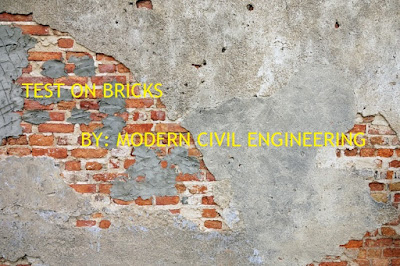Testing of bricks are conducted to ensure that bricks are of good quality which will used in construction. Brick testing are conducted on construction site as well as in laboratory. Bricks is one of important construction materials because bricks are durable, reliable, having good strength and low cost.
Bricks are smallest structural unit of any structure. So it is very important that brick should meet with some minimum standard. Thus there are some test for checking the properties of brick which are listed below according to property.
The Qualities of Good Brick which is used for construction of important structure should have following qualities:
Bricks are smallest structural unit of any structure. So it is very important that brick should meet with some minimum standard. Thus there are some test for checking the properties of brick which are listed below according to property.
1.Absorption Test:
A brick should be chosen randomly from stock and weight it in dry condition. Then immerse that brick in water for 16 hrs. Then weight the brick in wet condition. The difference between the weight indicates the amount of water absorbed by brick. The weight of absorbed water should not be exceed by 20 percent in any type of brick.
2.Crushing Strength:
These test is carried out by Compression testing machine. Press the brick continuously until the brick break into pieces. The minimum crushing or compressive strength of brick is 3.50N/mm2 as per IS:1077-1970. It should not be used in construction if strength comes less than 3.50N/mm2
For A class brick >14 N/mm2
For B class brick 7-14 N/mm2
For C class brick < 7 N/mm2
For A class brick >14 N/mm2
For B class brick 7-14 N/mm2
For C class brick < 7 N/mm2
 |
| Crushing Strength of brick |
3. Hardness:
A finger nail is used for these test. A scratch is made on brick surface with help of nails. If these is no impression on surface then brick is consider as sufficiently hard otherwise brick fails in the test.
4.Presence of Soluble Salts (Efflorescence Test):
A random selected brick is immersed in water for 24 hrs. Then brick is taken out and allow to dry in shade. If it show white or grey deposit, it indicates presence of soluble salt. If not, then the brick pass in the test. These test is based on efflorescence property.
Affected area Efflorescence rate
< 10 percent slight
10 to 50 percent moderate
5.Shape and Size:
In these test, 20 bricks are selected randomly and stacked acc. to length. Then all bricks should be closely inspected. All brick should have sharp edges and perfectly in rectangular shape.
The permissible limit of bricks should lies between
Length: 3680 - 3920 mm
Breadth: 1740 - 1860 mm
6.Soundness:
Two bricks are chosen and struck with each other. If it gives clear ringing sound, it is of good quality brick. If not then it is of poor quality.
7.Structure:
A visual inspection of brick will be performed in these test. It should of homogeneous, compact and free from any defect such as hole, lumps , cracks etc.
The Qualities of Good Brick which is used for construction of important structure should have following qualities:
- Uniform in shape, should be of standard size.
- Give a metallic ringing sound when stuck each other.
- Well burnt, table moulded, uniform in colour and bright.
- Homogeneous and uniform compacted structure and free from voids.
- Sufficiently hard and no impression should be left on brick when scratched with finger nail.
- Should have low thermal conductivity and sound proof.
- Should not show deposits of white salts when allowed to dry in shade after immersion in water for 24 hrs.
- Should have crushing strength more than 5.50 N/mm2
- Should not break into pieces when brick is drop on hard ground from height of 1m.
- For 1st class, absorption capacity should not be more than 20 percent by weight and for 2nd class, 22 percent and for 3rd class, 25 percent by weight when brick is absorbed in cold water for 24 hrs.
ALSO READ:
















1 Comments
Construction bricks suppliers in Ernakulam
ReplyDelete